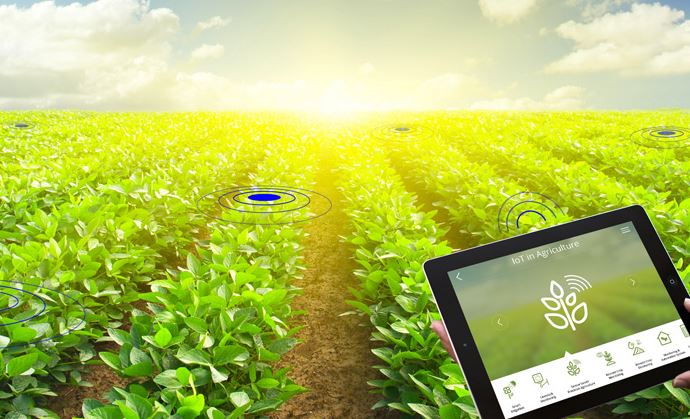Understand the definitions of commonly used terms in smart agriculture, including agriculture 4.0, agricultural data, the Internet of Things, agriculture as a service, precision agriculture, and more.

Aerial remote sensing images: Photographs taken from the air, usually done by drones, to help farmers determine the status of the field.
Agriculture 4.0: Similar to Industry 4.0, due to the emergence of intelligent technology in agriculture, it is an integrated internal and external network system for agricultural operations.
Agricultural chemicals: Chemicals used in agriculture, including fertilizers, herbicides and pesticides.
Agricultural data: Data from farm activities and conditions. Data can include soil analysis, nutrition information, seed selection, plant population, and yield data.
Agronomist: A person who specializes in agriculture.
Agronomy: The science of field crop production and soil management.
Algorithm: A mathematical formula that can be used to control variable rate applications.
Artificial intelligence: Computers simulate intelligent behaviour, such as decision making. AI can refer to anything from computer programs that play chess to speech recognition systems like Amazon Alexa, which are used to interpret and respond to speech.
Big Data: Information collected in a large number of different data sets through IoT sensors and devices.
Big Data Analytics: Examine a large number of different data sets (called big data) to reveal hidden patterns, unknown correlations, market trends, and customer preferences that can be used for decision making.
Central hub irrigation system: Apply a relatively uniform amount of water to the field.
Agriculture as a Service: Known as FaaS, this refers to the way farmers use subscriptions or pay-per-use for technology and data. For small to medium farms, this is ideal for data-driven decision making to increase productivity and efficiency, including farm management solutions, production assistance and market access.
Geographic data: Information about spatial location and monitored items, whether it is yield, number of seeds, or other factors.
Geo-reference: Adds geographic data to other field properties that are generated in real time or after data is collected.
Global Positioning System: A system that uses satellite signals to locate and track the position of the receiver/antenna on the Earth.
Grid map: Soil or plant samples can be obtained to analyze predetermined location information in the field. This information can be used to assess fertility requirements and to determine the approximate location of different fertilizer applications.
Internet of Things: The Internet of Things includes billions of devices connected to the Internet via sensors or Wi-Fi. Each device collects data and these data (collectively referred to as big data) are exchanged and analyzed.
Machine data: Information about how the device works. This can include fuel consumption, machine health indicators, diagnostic codes, and engine performance.
Machine learning: Machine learning is a sub-area of artificial intelligence. The core principle is that the machine acquires data and learns by itself.
Precision Agriculture: Also known as Smart Agriculture or Precision Agriculture. It includes a range of technologies, including remote sensing, IoT devices, robotics, big data analytics and artificial intelligence to create an integrated crop production management system at a specific location to increase profits, reduce waste and maintain environmental quality.
Agricultural production: A series of agricultural activities and the resulting agricultural products will be sold in the market.
Remote sensing: Scanning objects by satellite or high-altitude aircraft to obtain information without direct contact between the sensor and the object.
Row Seeding Tractors: Tractor with adjustable tread width that allows the tractor to pass through rows of corn, tomatoes or other crops without damaging the plants.
Self-driving tractor: An automatic agricultural vehicle that delivers high torque at low speeds.
Smart Agriculture: Using new technologies to change farming methods for centuries.
Soil map: A map showing differences in soil properties such as texture, fertility, organic matter, and farmland pH.
Sustainable intensification: The goal of agriculture is to increase the production of existing farmland while minimizing damage to the environment, conserving biodiversity, and protecting the land for future crops.
Telematics: Integration of communications and information technology to send, store and receive information from telecommunication devices to remote objects over a network.
Total factor productivity: A measure of agricultural productivity that considers all land, labour, capital, and material resources used in agricultural production and compares it to total crop and livestock production.
UAV: An unmanned aerial vehicle, an aircraft that is driven by a remote or onboard computer, usually called a drone.
Variable irrigation: An emerging technology used in conjunction with a central hub irrigation system.
Weather data: Information about precipitation, wind, temperature and other climatic conditions.
Yield Map: A map showing the difference in field crop yields.
Related Posts
What is Open source IoT stack?
11 Best Open source IoT Platforms To Develop Smart Projects
Benefits of IoT Solutions in Pharma Sector
How simple technologies help to boost Agriculture & farmers growth
Letstrack wins Aegis Graham Bell Awards for Innovation in IOT
TRAK N TELL makes a major thrust on Vehicular Telematics